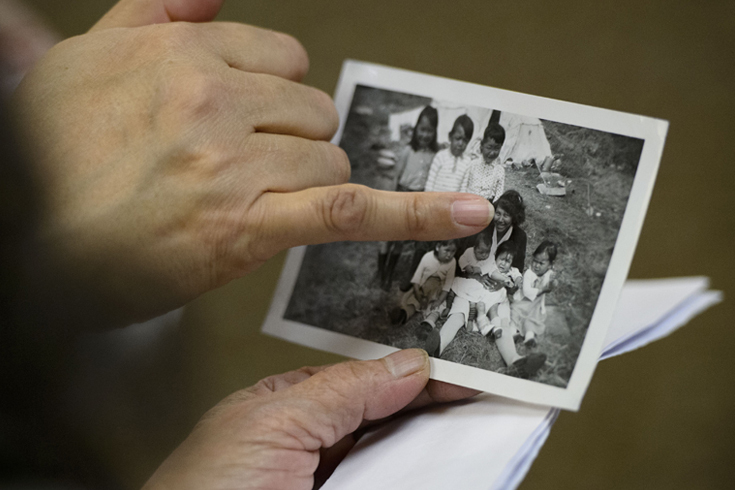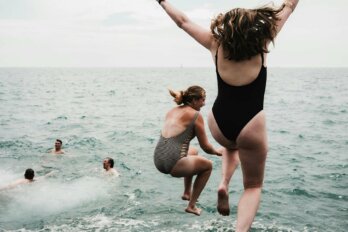In a meeting in late February, Minnie Grey fields regional councillors’ questions about the novel coronavirus tearing around the world. Speaking in Inuktitut, the executive director of Nunavik’s health and social-services board says the virus likely won’t reach the Inuit region in northern Quebec, which is only accessible by air. But community health care centres have to prepare for cases nonetheless. Infectious diseases, she reminds her colleagues, aren’t new here: “We’ve seen tuberculosis cases again and again.”
Tuberculosis has plagued the North since it arrived with whalers in the late nineteenth century. At its peak, in the 1950s, it infected one in three Inuit in Canada. Medical ships carried up clinicians from the south and served as test sites for the bacterial infection; “TB” was written on the hand of anyone who tested positive. Those patients remained on the ships and were sent south for treatment, often given no time to return to shore and pack or say goodbye. Families were separated for years at a time and were often not informed when their loved ones died. The federal government’s treatment of Inuit during the tuberculosis epidemic prompted an official apology last year. But the story of tuberculosis in the North doesn’t end there. Health care for northerners relied on that evacuation to the south; fundamentally, it still does. As long as the region lacks robust health care infrastructure, infectious diseases like tuberculosis—and, now, COVID-19—pose an unmitigated threat to Inuit.
The legacy of tuberculosis in the North is a symptom of broader inequities that Inuit communities have confronted for decades. By the 1950s, once antibiotic treatments for tuberculosis became available, the infection rate began falling among people born in Canada—except Inuit, as well as First Nations and Métis people. Today, rates of tuberculosis remain 300 times higher among Inuit than others born in Canada.
The continued lack of access to health care, where more often than not a visit to the doctor requires boarding a flight to a larger community or to the nearest southern city, is one of several factors that have allowed tuberculosis to persist. Across Inuit Nunangat—the Inuit homeland in Canada, which includes the Inuvialuit region, in the Northwest Territories and the Yukon; Nunavut; Nunavik, in Quebec; and Nunatsiavut, in Labrador—more than half of residents live in overcrowded housing, compared to 8.5 percent of non-Indigenous people in Canada. In 2012, more than 50 percent of adults in Inuit Nunangat experienced food insecurity. Illustratively, the life expectancy of Inuit is about ten years shorter than that of other Canadians. All of this beckons the spread of infectious disease.
Though tuberculosis and COVID-19 are different diseases entirely—the latter is caused by a viral infection rather than a bacterial one—both have the potential to thrive under the same conditions. The ongoing story of tuberculosis in the North could be a harbinger of COVID-19 in Inuit communities. But it doesn’t have to be.
There were no cases of COVID-19 in Nunavik as of that meeting in February, and there wouldn’t be for another month. But they did come.
As of this writing, Nunavik has sixteen confirmed cases—at least eleven of those in the community of Puvirnituq. (Nunavut, across the Hudson Strait, is the only province or territory in Canada without any cases of COVID-19.) Local health teams quickly traced the majority of Puvirnituq’s cases to the same point of origin—a task that is arguably easier in a community of a few hundred or thousand people than in a densely populated city. It’s also a task northern health officials are familiar with.
“The biggest skill that can be transferred from tuberculosis to COVID-19 is the contact-tracing, the ability to interview people and identify who is at risk of transmission of an infection,” says Michael Patterson, chief public health officer for Nunavut.
To ward off the risk of importing the virus, northern regions have tried to limit travel: Inuit workers have been sent home from northern mines in an effort to prevent them from catching the virus from southern colleagues, one fishery has kept Inuit crew members off boats, and scientists have cancelled field seasons. To enter Nunavut, there’s now a mandatory two-week quarantine, at specific hotels in the south and in Yellowknife, before boarding a flight. Since mid-March, commercial flights in and out of Nunavik have been reduced and then cancelled, and nonessential travel between communities—by plane or by snowmobile (the communities are not linked by road)—is banned. But, with the North’s reliance on the south for food, fuel, and health care, to name a few essentials, barricading its borders isn’t entirely possible.
Aluki Kotierk, president of Nunavut Tunngavik Inc (NTI), the organization that represents Inuit living in Nunavut, says preparing for the novel coronavirus meant not only reiterating national public health guidelines—to stay home, wash hands, and practise physical distancing—but also making it possible for people to follow them. The staff and board of NTI knew that fastidious handwashing ran counter to water conservation—a must when you live in a crowded household, as so many Nunavummiut do, or when water trucks fill your cistern only two or three times a week, as is the case for some Nunavut homes. The organization invested $1.25 million from the federal government’s Indigenous Community Support Fund, issued in late March, to raise the frequency of water deliveries to daily for the month of April.
“For a population that has a vast number of people living under the poverty line, that has a vast majority of people living in overcrowded housing units, it’s much more difficult to practise these very basic instructions,” says Kotierk. She hopes that this use of federal funding will highlight the need for a more long-term solution for northern infrastructure. Every opportunity she has to speak to federal ministers, Kotierk says, she tries to illustrate these hurdles as well as the logistics at play when one region is so reliant on another part of the country for basic health care services.
In the meantime, Inuit regions are preparing their beneficiaries with the resources they have. Nunavik’s Kativik regional government dug into its budget to provide grocery vouchers to any household whose income shrank as a result of the pandemic: $400 per week for a family of four. Before federal funding flowed across Canada, replenishing pockets and ledgers emptied by the novel coronavirus, NTI also rearranged its own accounts to find a boost in funding for Nunavut harvesters so they could supply communities with nutritious, fresh game when hunting is costly and not an option for everyone. The job losses that followed the coronavirus around the world since January hadn’t yet hit, but it was clear that what was coming would put those facing food insecurity in an even tougher position. In light of the experience they had managing tuberculosis, Kotierk says, she and other regional leaders “know that, if people have a well-balanced, nutritious, regular source of food, their bodies will be in a better position, and their immune systems will be in a better position, to fight off infectious diseases.”
In the east, the government of Nunatsiavut is providing household cleaners, disinfectant wipes, and soap to anyone who needs it. Funding for families to spend time on the land, away from communities, has been ubiquitous in Inuit organizations’ responses to the threat of COVID-19; while southerners are urged to stay in place, cabins and camps across the North are a suggested refuge from tight quarters in town. In the northwest Arctic, the municipality of Cambridge Bay, Nunavut, built three outdoor hockey rinks in mid-March to keep residents active after the indoor rink was locked up due to COVID-19 precautions. Of course, only ten skaters are allowed on the ice at a time in order to maintain safe distances. Cambridge Bay was also one of the first Nunavut municipalities to politely ask visitors to stay away.
Johnny Kasudluak lives in Inukjuak, Nunavik, a community of about 1,500 people on the east coast of Hudson Bay. The village government put a call out for residents to hunt nearby caribou to help supply the community. Kasudluak’s son got two and, along with other hunters, brought them to the community freezer, where staff divided up the meat and delivered it to residents, Elders first. “There’s nothing new, really, in the community coming together in a time of crisis,” says Kasudluak. “It’s just a natural thing for us, living up north in an isolated region.”
Kasudluak’s mother has dementia and is in long-term care at the health centre in Puvirnituq. The region’s other health centre is in Kuujjuaq, while the remaining twelve communities are serviced by nursing stations. As of March 15, visitors were no longer allowed in health centres or elder-care facilities due to the risk of bringing the novel coronavirus to vulnerable people. Respect for Elders is fundamental to Inuit culture—they are the vessels of that culture, the teachers and historians. Keeping a distance is a particular challenge. New rules around visitation meant that, even though Kasudluak was already in town to see his mother, he no longer could.
Now, he speaks to his mother over the phone, though not too often as the conversations can be confusing for her. “There’s no available technology where we could FaceTime or anything like that,” he says.
On April 19, just a few days after we spoke, Inukjuak’s first case was confirmed. Like nearly all of the cases in Nunavik before it, this patient was recovering at home. Only one patient was admitted to the health centre in Puvirnituq for COVID-19. While there are ventilators available in both Nunavut and Nunavik, none of the regional hospitals have intensive care units to treat severe cases, so ventilation means boarding a medevac flight to a city down south, away from family, friends, and community—a troubling echo of the tuberculosis epidemic.
In 2018, as part of a pledge alongside Inuit Tapiriit Kanatami (ITK), the organization that represents Inuit in Canada, to eradicate tuberculosis in Inuit Nunangat by 2030, Prime Minister Justin Trudeau promised $27.5 million over five years. That funding was of course welcome, says Natan Obed, president of ITK, but what’s really needed is the sort of investment that shortens the spectrum of social equity across the country when it comes to health care, housing, water, and food security.
The major hurdle for this transformation is the scale of investment needed to refurbish health care systems in the North such that they mirror those in the south rather than relying on them. “Canada has provided massive investments for the country in the west, in the Pacific region, in the east. At one point or another, the federal government has put massive amounts of money into creating continuity and equity within Canadian society,” says Obed. “It has never done that in Inuit Nunangat.”
With the northern health care system so reliant on air travel, the government of Nunavut has spent more than $2 million a week during the pandemic to keep northern airlines flying when there’s virtually no commercial demand, premier Joe Savikataaq told reporters on April 15. Anyone who has flown in the North knows the arrangement of planes, walled off toward the back to separate passengers and cargo—which includes any northbound food, hygiene products, and other goods this time of year, when the Arctic Ocean is still frozen and supply ships can’t access communities. Southbound cargo now includes swabs en route to laboratories outside the territory to be tested for the novel coronavirus. If planes fly only once a week, so do test kits. The ITK put a call out to the federal government to deem air transport an essential service in the region during the pandemic for this very reason. And it’s a reason, Aluki Kotierk says, that capacity needs to be built up so diagnostic testing for northerners can be done in the North.
Nunavik has already started using its GeneXpert machine, purchased to test for tuberculosis, in Kuujjuaq and Puvirnituq to detect the novel coronavirus. The test requires disease-specific cartridges, and the United States Federal Drug Agency recently approved cartridges to test for COVID-19. Their use would mean a much earlier indication of the virus than a plane ride to a lab can offer—about forty-five minutes after the test is taken. Nunavut is also using GeneXpert cartridges for any close contacts of the territory’s first confirmed case. In both Nunavut and Nunavik, the tests are being used only in emergencies because supplies are limited.
Beyond testing, Obed posits what might happen if the southern jurisdictions the North relies on for services are overrun with cases of COVID-19 and don’t have the capacity to bring in outside patients. So far, this hasn’t been an issue, Obed says, but for him, such concerns serve as a constant reminder that, without equal access to a comprehensive system in Inuit Nunangat, the health of Inuit is in someone else’s hands.
Kotierk tells me that, the night before our interview, she watched an evening news segment in which US president Donald Trump puzzled over the comparatively higher rates of COVID-19 among Black people in the United States. “I was thinking, I know why. I totally get it. It does not surprise me,” she says. “To me, it’s the social inequity that people face. And I would argue it’s the same for Inuit in Canada.”





